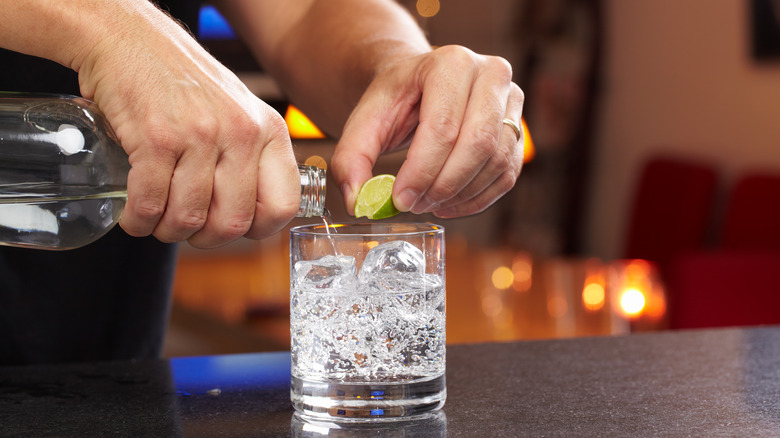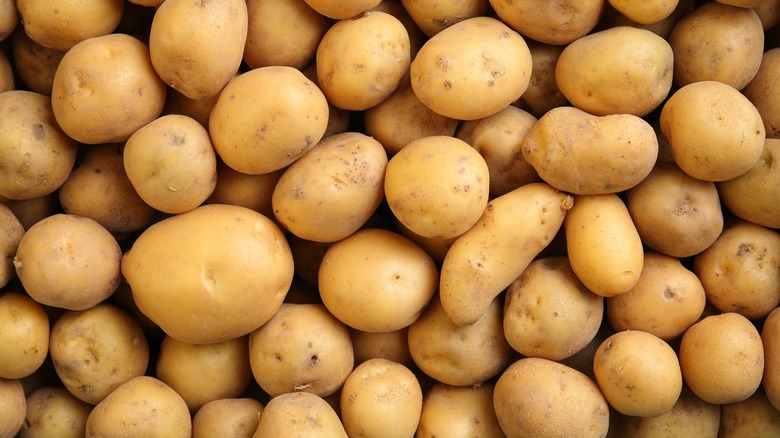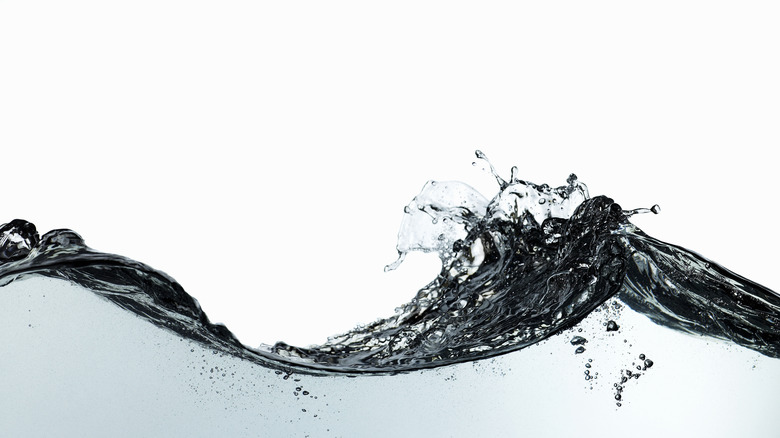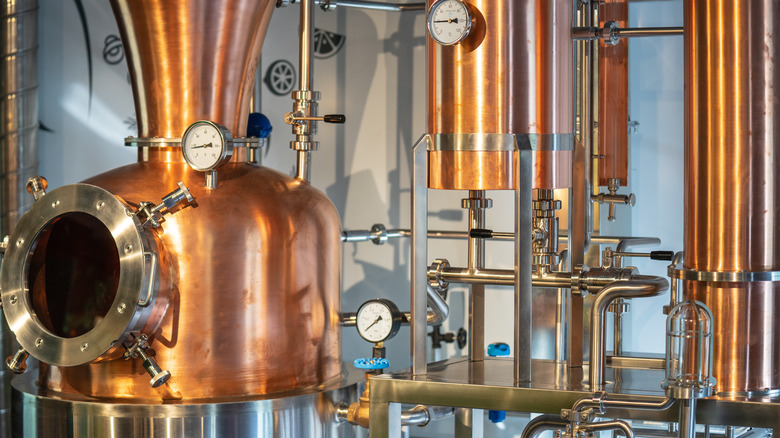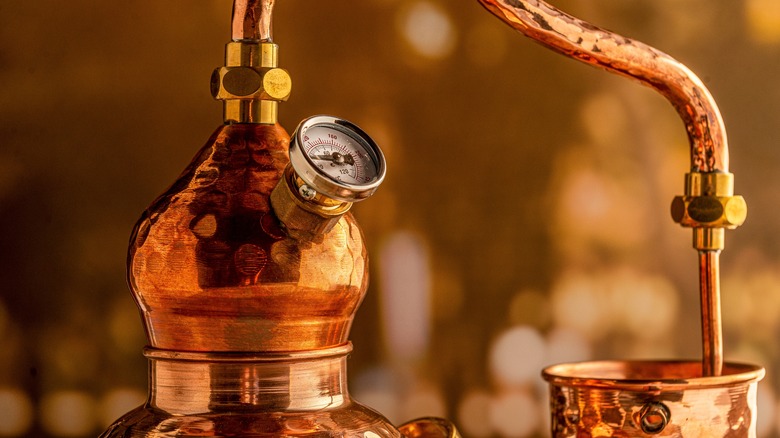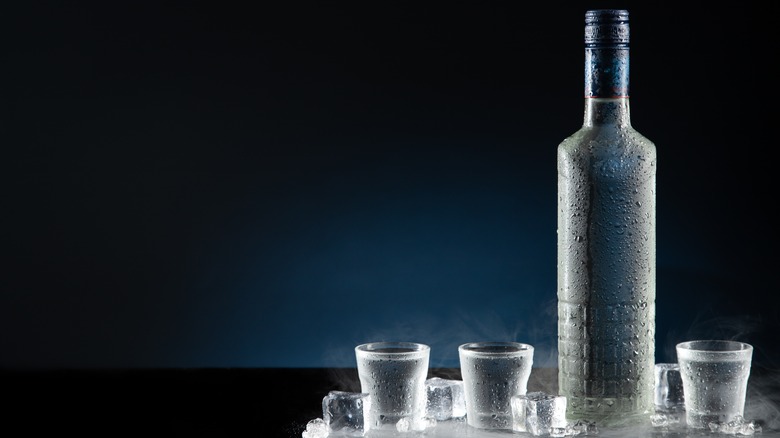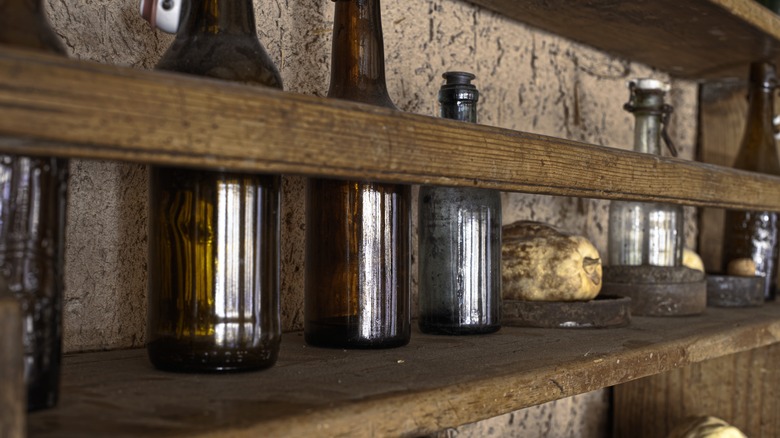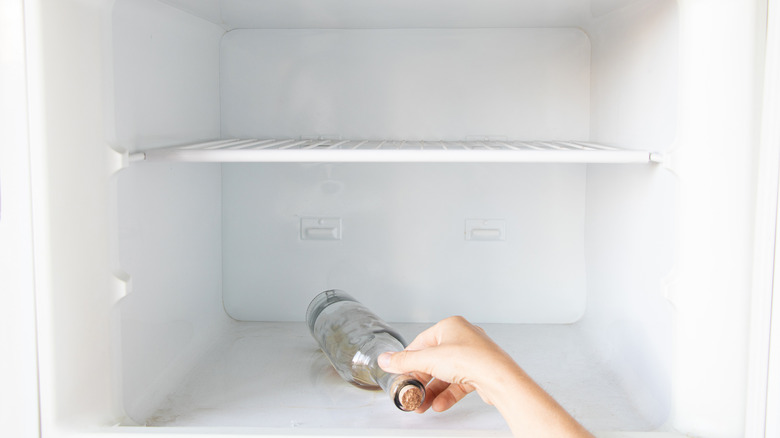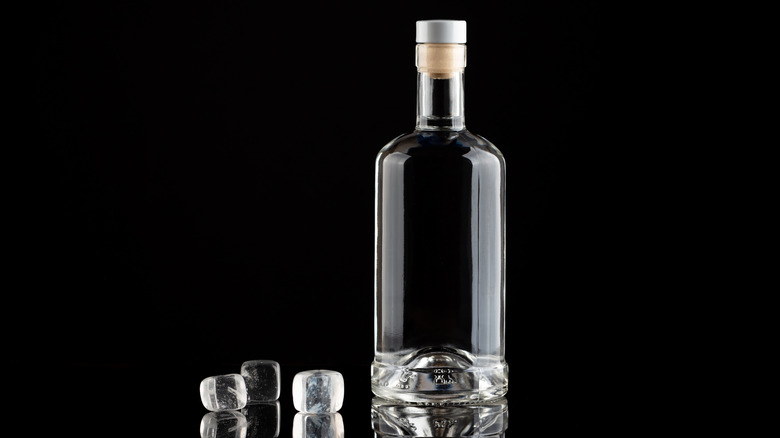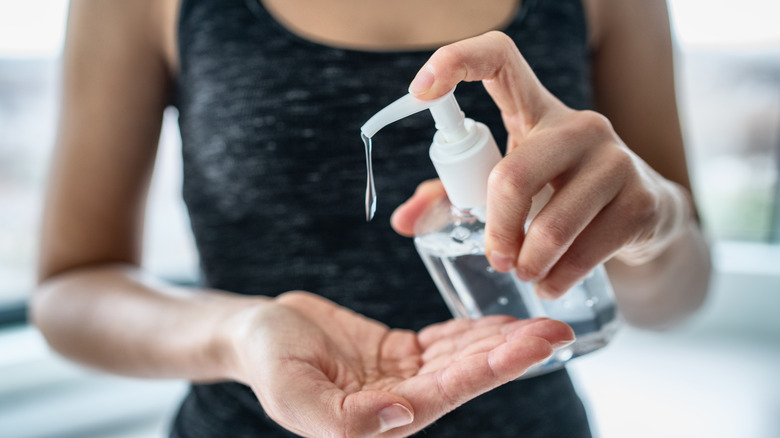Secrets Of Vodka You'll Wish You Knew Sooner
There's a reason vodka is America's favorite and most-consumed liquor since the '70s, per The Drinks Business. These days, if Americans drink an average of 78.1 million cases of vodka in 2021, according to the Distilled Spirits Council of the United States, it's no doubt in part due to its approachability and versatility. The spirit can easily be combined with a variety of mixers from fruit juices to sodas and liquors, and it can even be infused with fruits, spices, or other flavors to craft novel versions that can easily stand on their own. Premium vodkas, meanwhile, are perfect for sipping neat and reveling in their smooth texture and the fullness of their aromas.
But despite its clarity, vodka has a few tricks up its sleeve — even though most major vodka producers keep their production methods a secret. Did you know, for example, that Vera Wang claims one of the secrets to her youthful appearance is a regular vodka cocktail? Or that vodka was originally marketed as a medicine? Here are the secrets of vodka to whip out at your next cocktail party.
Vodka isn't always made with potatoes
Most people assume that vodka is made by distilling potatoes, but this is far from the whole story. While it can be made from potatoes, vodka's main characteristic is that it needs to be a clear spirit distilled to 190 proof from a fermented mash. This occurs when a sugar-rich staple ingredient is broken down by active enzymes to make fermentable sugars.
Many of the most popular vodka brands begin with barley, rice, corn, or rye. While potatoes might be the most commonly known source of vodka, the spuds only account for about 3% of the world's vodka production. That said, some vodka producers do indeed capitalize on the flavor of the root vegetable to craft unique vodkas with loads of earthy aromas. These producers tend to use thin-skinned, starchy varieties like Stoflavbrawa or Russet Burbank for results that fully display the terroir of the core ingredient.
Good water is essential for good vodka
Aside from the grain, fruit, or tuber being distilled, vodka requires just two other ingredients: yeast and water. With so few ingredients, they must all be of the very best quality, and that goes double for the water. After all, this liquid makes up the remaining 60% of what's in the bottle (aside from alcohol). If you have any doubts about its essential role, remember that it's what gives vodka its name in the first place, derived from the Russian word for water.
Water, according to Vodka Distilled author Tony Abou-Ganim, lends much to the final character and texture of vodka. "A lot of producers use almost dead water, meaning distilled or treated in such a way that you remove all the impurities, and you lose a lot of character of the water itself," he tells Liquor.com. "Water has a great effect on the overall character of the final distillate and contributes to texture and mouthfeel."
Still, not all producers disregard water quality, such as Grey Goose, which prides itself on using only pure water from the Gensac spring in the southwest of France for a pure flavor and smooth texture.
There are multiple ways to distill vodka
Vodka is a distilled spirit, which means that it is made by transforming liquid into vapor and then condensing it back into a liquid. This separates the alcohol from the fermented solids, giving you a pure, clear finished product. But there are multiple ways to skin a cat — or distill a liquor. When it comes to vodka, two major methods are used: pot and column.
Pot distillation is perhaps the more ancestral of the two, having evolved from 9th-century alembic distillation. The fermented grain mash is heated in giant copper pots until the liquid boils and transforms into vapor. It then travels through a narrow pipe to be transformed back into a more alcoholic and purer liquid form. Column distillation is a newer method dating to the 19th century. It consists of pot stills stacked into copper or stainless steel columns, allowing for continuous distillation. Whereas pot-distilled vodkas retain a bit more flavor and character, continuous distillation leads to a purer, cleaner flavor, since the process removes more of the impurities in the original mash.
More distillation doesn't necessarily mean better vodka
It's become trendy, of late, for vodka brands to crow about the purity of their quadruple distilled vodka. Although distilling multiple times is done in traditional vodka production, more isn't necessarily better in this case. After the product is distilled, the resulting liquid is typically filtered through charcoal, removing any remaining impurities that would affect the taste.
Felene Vodka's Master Distiller Tim Kelly explains that the first distillation produces what's referred to as a "low wine," made up of both alcohol and other compounds, which is then distilled again to render it purer and more neutral. But upwards of two or three distillations, according to most experts, is performative at best and can even make your vodka worse. Over-distilling vodka can remove its subtle natural aromas, rendering it harsh and even unpleasant. So steer clear of vodkas that have been distilled upwards of 10 times — you'll likely pay more for a product with less character.
Vodka isn't necessarily odorless or flavorless
If vodka is so popular, it's perhaps because it isn't known for having much of a personality. Famed for being odorless and flavorless, it's easy to integrate into mixed drinks precisely because it doesn't have a ton of aromas of its own. Indeed, according to Victorino Matus, author of "Vodka: How a Colorless, Odorless, Flavorless Spirit Conquered America," vodka's clean, pure aesthetic is part of what catapulted it to popularity in America in the '60s. When vodka does have flavor (often bitter) it's usually a bad sign, associated with cheaper vodkas we all remember from our college days.
But some premium vodkas do indeed have a flavor, such as Karlsson's Gold Swedish, featuring virgin potatoes from Cape Bjäre, or premium Grey Goose, made with Northern French winter wheat. As vodka brands bring out these subtle flavors, some spirits lovers have taken to drinking the liquor neat to savor its delicate aromas.
You really shouldn't try that Brita vodka hack
Recently, a hack went viral on TikTok (albeit one that had already gone "viral" back in the early aughts on "Mythbusters") that seemed to show a trick to turn vodka into water. (A far less popular party trick than the opposite transformation.) TikTokkers took to the platform to pour cheap vodka through a Brita filter, only to find that the resulting liquid tasted like water.
Turns out this works — but it doesn't make vodka any less alcoholic. Water filters like Brita rely on an activated carbon filter to reduce the chlorine flavor of tap water. This filter also works to reduce the strong smell and taste of cheap vodka. But don't let your taste buds fool you: The vodka still retains its full alcoholic content, and using your Brita to change the taste could lead to irresponsible consumption. Still, if you stay vigilant and limit your intake, this trick could be a way of reducing the firewater quality of many bottom-shelf vodkas.
Vodka can expire
Distilled alcohols like vodka have an incredibly long shelf life thanks to their high alcohol percentage. This creates an environment that isn't welcome to the sort of microbes that generally make foods and drinks go off. Stored in ideal conditions — in a cool, dry, and dark location — a sealed bottle of vodka can be kept almost indefinitely. (Producers generally recommend not to keep it longer than 50 years, though for most mortals, that's far from an issue.) Once open, vodka's shelf life decreases slightly, but you're still looking at somewhere between 10 and 20 years of enjoyment.
The one exception to this rule is the category of flavored vodkas, which have a significantly shorter shelf life of about three years. This is due to the presence of sugars, which causes it to oxidize more quickly. Storing these vodkas in the fridge can increase their shelf life slightly, but it's best to consume them quickly (and responsibly!) to enjoy them at their very best.
Vodka shouldn't be stored in the freezer
If you've been keeping your bottle of vodka in the freezer, it's time to change your ways. Unopened vodka is perfectly happy at room or cellar temperature, so there's no need to take up valuable freezer real estate with a sealed bottle. An open bottle, meanwhile, should indeed be kept chilled and ready to drink — but not in the freezer.
Freezing vodka doesn't exactly harm it, but it does modify its viscosity and dull the subtle flavors lent by the volatiles in the vodka. While this might be an asset for a bargain bin vodka, if you're buying top-shelf stuff, you're essentially diminishing your investment by sticking the bottle in the freezer. Instead, keep your vodka in a cool place and serve it in a chilled glass over ice for a crispness that doesn't do away with any of the drink's aromatic potential.
Storing vodka out of direct sunlight will keep it fresher longer
Temperature isn't the only storage concern when it comes to vodka. While the liquor does indeed have a long shelf life, choosing the right place to store it can keep it fresher for even longer. Most importantly, keep the bottle out of direct sunlight, which can cause the precious liquid to evaporate.
With premium vodkas like Grey Goose that have a cork stopper, be sure to store the bottle upright. As opposed to wine, which should be stored on its side so the cork doesn't dry out and cause oxygen to enter the bottle, vodka should not come into contact with the cork stopper. This is to prevent the cork from degrading over time due to prolonged contact with alcohol. Giving the bottle a shake from time to time will keep the cork moist and will also help any alcohol that has evaporated into the bottle's neck to become reintegrated into the liquid.
You can cook with vodka
Cooking with wine or beer is commonplace, but cooking with vodka deserves way more attention. While it might seem like the liquor wouldn't add much flavor to your recipes, it turns out vodka is a wonderful ingredient, thanks in large part to its effect on texture. Vodka boasts emulsifying properties, which can help sauces and marinades bind, rendering them silkier and smoother — and without leaving much trace of flavor, as more assertive alcohols do.
But that's not the only way you can use vodka in the kitchen. What it lacks in flavor it more than makes up for with its status as a flavor enhancer, bringing out the best in your sauces and stews. It's part of the reason it's so welcome in simple pasta sauces like penne alla vodka. Finally, seeing as alcohol does not contribute to the formation of gluten the same way that water does, vodka is essential for making a flaky and tender pie crust.
Vodka was originally used medicinally
If you've ever over-indulged in vodka, you may find yourself reaching for the medicine cabinet, but it turns out that at the outset, vodka itself was originally the medicine. Thanks to a whopping 40% ABV, vodka was long used as an antiseptic or disinfectant. And while it pales in comparison to the ABV of modern rubbing alcohol, boasting 70% ABV, vodka could have been essential in a time before such products were widely available. Similarly, in times when analgesics were thin on the ground, notably for soldiers at war, vodka might have been used to provide pain relief.
In the past, vodka has even proven popular as a fever reducer, although most modern sources warn vehemently against bringing this traditional use into the modern era. Pediatrician Maureen Ahmann, DO, tells the Cleveland Clinic that applying alcohol to the skin cools it only temporarily, and doing so is dangerous for children. The alcohol can be absorbed through the skin, causing severe health problems including alcohol poisoning or even coma.
